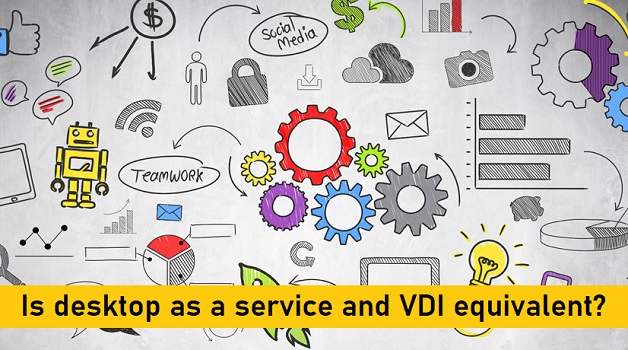In this article we will see Is desktop as a service and VDI equivalent?
You may install virtual machines (VMs) as an on-premises or cloud resource using virtual desktop infrastructure (VDI) technologies. The same functionality is supplied by Desktop as a Service (DaaS) solutions, but cloud companies provide these managed services. Cloud service is not the only distinction between VDI and DaaS, though.

Virtual Desktop Infrastructure (VDI): What Is It?
You may deploy desktops using virtual machines (VMs) that are maintained on-premises or in the network, thanks to VDI technology. These desktops are distributed to user PCs and controlled from a central server. This desktop virtualization technique was once known as end-user computing (EUC), but VMware popularized the name VDI.
Desktop as a Service (DaaS): What Is It?
Similar to VDI, cloud suppliers offer DaaS as a managed service. Virtual desktops are managed on a controlled public cloud and remotely distributed to user computers in DaaS services. These services are invoiced on a subscription model and can be bundled with other cloud providers’ services.
Read more: – What are the types of airline services?
VDI vs. DaaS: 5 Major Disparities
VDI software and DaaS installations have various advantages and difficulties, although having a similar end goal. The differences between these two solutions are explained in the comparison chart below.
- Platform
You are responsible for all installation, upkeep, and administration in VDI deployments. If installations are hosted locally, this entails caring for and housing both physical and virtual computers.
When you host installations in off-site cloud infrastructure, your host provider may manage the infrastructure for you and keep it up to date. DaaS deployments handle your infrastructure, so you don’t have to worry about upkeep or management.
- Multi-tenant versus single-tenant
Resources allocated to a single company or user are the foundation of single-tenant VDI implementations. This architecture gives you total control over how your resources are distributed and configured. It also removes the possibility that the resource demands of other users would impact your own deployments.
The majority of DaaS services, in contrast, are built on multi-tenant architectures. These methods involve hosting your service in data centers or servers available to other businesses.
- Control
You generally have complete control over the infrastructure, settings, and data in VDI installations. Additionally, it is simpler to guarantee that only registered persons may access data since a single tenant design is employed.
You can precisely control who has access to data, where it is kept, how devices are monitored, and which tools are utilized using VDI. In DaaS installations, the provider is in charge of numerous setup, monitoring, and computer storage decisions as well as your infrastructure.
- Cost
Significant capital expenditures (CapEx) are necessary for VDI implementations, especially if you buy or update systems and data centers. Organizations may start paying off technical debt after purchasing and configuring technology, and they won’t have to bother about recurring subscription fees. The initial investment is frequently less expensive than DaaS for enterprise-grade enterprises with known growth and resource needs.
In contrast, DaaS implementations suffer recurring subscription payments rather than practically any CapEx. This cost model guarantees that you are only spending for the assets you actively utilize while also making it simpler to scale activities dynamically.
In contrast to VDI, DaaS installations can usually be set up and operational quickly. This is since the platform and infrastructure are all set up for you; you only need to specify desktop configurations and users.
With DaaS services, scaling requires ordering extra desktop instances or customer licenses. You don’t have to spend money on new gear or time setting it up.
Read more: – Top Cost-Cutting Techniques for 3D Printing and CNC Machining



